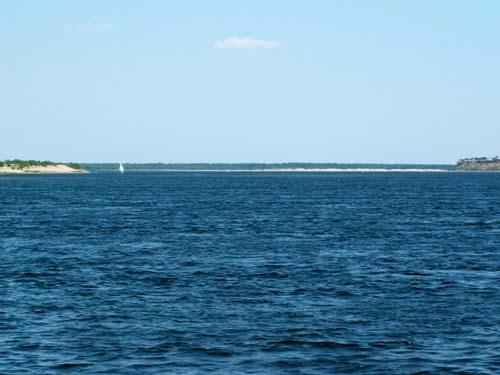Ministry names main sources polluting Caspian Sea

By Leman Mammadova
In addition to the level hesitation, pollution of sea water and the degradation of ecological conditions are the most important problem of the recent period among Caspian Sea problems.
Ministry of Ecology and Natural Resources of Azerbaijan named main sources of pollution of the Caspian Sea.
There are unregulated currents that pollute the Caspian Sea, the ministry employee Mirsalam Ganbarov said, Trend reports. Through these streams harmful waste is discharged to the sea without purification.
The Caspian Sea is most polluted by domestic household waste and reservoir water generated during oil and gas production. The enterprises that pollute the sea are mostly Surakhani Oil Company, Balakhani Operating Ltd and Azgerneft LLC.
Ganbarov said that wastewater, mostly formed in rural and urban settlements without sewerage, is discharged into the sea through lakes and ponds.
“It is possible to avoid such pollution sources. For example, the wastewater produced by the the oil and gas production departments of Azneft Production Unit, as Absheronneft, Bibiheybat, H.Z.Tagiyev, N.Narimanov and Binagadi Operating Company are well managed. That is, no waste water is discharged to the Caspian from these facilities today. This means that other companies that pollute the Caspian can take appropriate measures,” he noted.
Improving the environmental situation in the Caspian Sea is directly related to the functions of the ministry, so we are working to take more strict measures, he added. All sources of contamination of the sea are monitored, Ganbarov said.
The Caspian Sea area, which has no direct connection with the World Ocean, is 380,000 square km. The ancient written sources called the Caspian Sea as South Sea, Caspi, Hirkan, Gilan Sea. However, basically, the name of the Caspian Sea was taken from Caspian tribes settled on its shores.
The fauna and flora of the Caspian Sea have a unique richness. It is distinguished from other seas and lakes. The fauna of the Caspian Sea differs significantly from the typical sea fauna. There are three reserves in the coastal zone of the Caspian Sea: Gizil-Aghaj in Azerbaijan, Astrakhan in Russia, Khazar in Turkmenistan. There are about 920 types of animals in the Caspian Sea as well as 101 different types of fish and forms.
At present, there are about 15 million people in the Caspian coastal zones, whose life activities are directly related to the sea (mainly fishing). Caspian Sea is the only fertile water area in the world, with a large reserve of sturgeon (about 95 percent) concentrated here. It is known that sturgeon is a "manufacturer" of black caviar, which is considered to be very valuable in the world market. Therefore, the gene pool of these fish in the Caspian Sea is strictly protected. Note that the main export of black caviar on the planet accounts for residents of this lake. Nevertheless, the wealth of the Caspian Sea is not exhausted. For oil and gas reserves, it is one of the largest hydrocarbon raw centers in the world.
At present, the ecological situation of the Caspian Sea is quite intense. The problem in the sea shelf zone is even worse, there are already dead zones in these areas.
The Caspian pollution sources are quite diverse - pollutants that flow through the river, pollution from cities and industrial facilities located in the coastal zone, contamination with oil extraction and transportation on the sea, pollution from flooded sources in the coastal zone as a result of the rise of the Caspian Sea level.
The most dangerous contamination for the Caspian Sea is pollution with hazardous chemicals. These include oil hydrocarbons, carbohydrates, chlorine organic compounds, and heavy metals that seriously undermine the aerating process, leading to the destruction of marine fauna and flora.
Coastal states should take serious steps to ensure environmental cleanness of the Caspian Sea.
The Framework Convention for the Protection of the Marine Environment of the Caspian Sea is the first legal agreement between the five Caspian littoral states reflecting the conditions of nature protection and the relevant organizational mechanism in the Caspian Sea Region.
The Agreement, also known as the Tehran Convention, aims at preventing the pollution of the Caspian Sea from all types of sources, protecting, preserving and rehabilitating the marine environment, including the sustainable and rational use of biological resources and environmental impact assessment.
August 12 is celebrated as a Day for Protection of the Environment of the Caspian Sea since the Convention has been ratified on August 12, 2006.
The main purpose of celebrating the Caspian Day every year is to protect the environment from pollution, including the protection, conservation, rehabilitation, sustainable and efficient use of the Caspian Sea biological resources and educate the population in this direction
The same day also known for signing a historic document for the region - Convention on the Legal Status of the Caspian Sea. The so-called "Constitution" of the Caspian Sea, was signed on August 12 2018 at the fifth Summit of Heads of the Caspian littoral states in Aktau, after 22 years of systematic talks.
---
Leman Mammadova is AzerNews’ staff journalist, follow her on Twitter: @leman_888
Follow us on Twitter @AzerNewsAz
Here we are to serve you with news right now. It does not cost much, but worth your attention.
Choose to support open, independent, quality journalism and subscribe on a monthly basis.
By subscribing to our online newspaper, you can have full digital access to all news, analysis, and much more.
You can also follow AzerNEWS on Twitter @AzerNewsAz or Facebook @AzerNewsNewspaper
Thank you!
